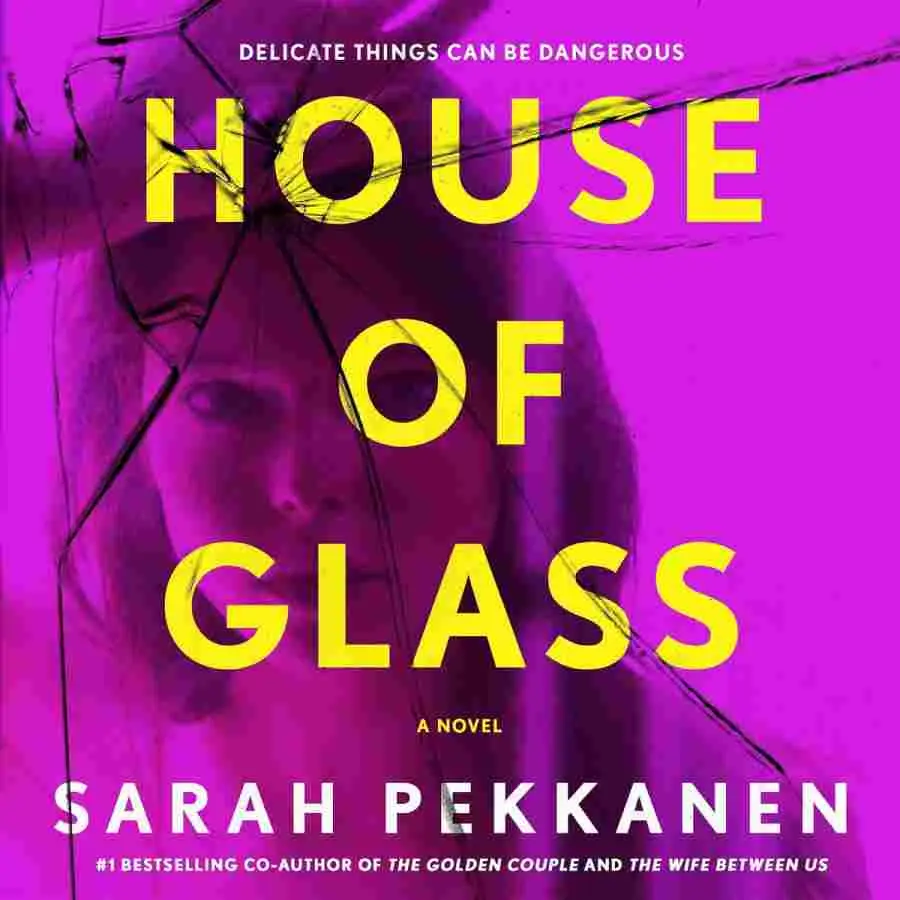

As an ardent reader with a preference for psychological thrillers, I often find myself drawn to works that promise a mix of tension, mystery, and complicated character relationships. It’s a genre that has captivated me for years, as seen by my bookshelves, which are stacked high with volumes that have kept me up late at night, unable to put down. So, when I discovered House of Glass by Sarah Pekkanen, I was instantly fascinated. Perhaps it was the scary summary, or Pekkanen’s reputation as a superb writer, but something about this book drew me in.
Journey into the World of House of Glass
Before I go into the intricacies of House of Glass, I’d like to tell you about my reading journey. I’ve read innumerable books from a variety of genres throughout the years, but psychological thrillers have always piqued my interest. The way these tales reveal the darkest aspects of the human mind, the unexpected turns, and the moral quandaries that make you doubt your own views all add to the genre’s fascination. I’ve previously been extremely involved in works such as Paula Hawkins’ The Girl on the Train and Gillian Flynn’s Sharp Objects. Each of these works, in its own way, investigates the vulnerability of the human psyche and the extent individuals will go to keep their secrets.
With House of Glass, I expected nothing less. The word alone implies fragility and transparency—or lack thereof—and the potential of a thrilling narrative set in an apparently ideal family’s house was too appealing to pass up. As I began listening to the audiobook, which was brilliantly delivered and full of suspense from the first chapter, I knew I was in for a trip.
A Mysterious and Suspenseful Plot
At the core of House of Glass is the Barclay family, who seem to have it all. They reside in a gorgeous, historic mansion in Washington, D.C., and their lives seem idyllic. However, it does not take long for the fractures in their veneer to appear. The plot begins with a horrible event: the death of the family’s young nanny, who falls (or is she pushed?) from a high height. Rose Barclay, nine years old, is the lone witness to this horrible occurrence, and she stops speaking completely in the aftermath. Her sudden muteness is as mysterious as the nanny’s death, and it is this combination that drives the novel’s tension.
Rose’s silence is more than simply a response to pain; it becomes a major riddle for the heroine, Stella Hudson, to unravel. Stella is a best interest attorney who often defends older children in custody disputes. Despite her doubts, she is convinced to take up Rose’s case by a judge she holds in high regard. Stella’s personal history, which is recounted in snatches throughout the book, makes her hesitant to deal with younger children, but she accepts because she is captivated to the case’s intricacy and the intriguing Barclay family.
Stella rapidly understands that nothing about the Barclay family is what it seems to be. Each member is concealing something, and the more Stella investigates, the deeper she discovers layers of deception and treachery. The novel’s tension rises as Stella navigates the complexities of the family’s relationships, all while attempting to protect Rose and discover the truth about the nanny’s murder.
Character Development: The True Strength of the Novel
The complexity of the characters in House of Glass is one of its most captivating qualities. Sarah Pekkanen has a gift for crafting complex people that seem genuine and accessible, despite the frequently remarkable situations they find themselves in. This ability is on full show at House of Glass.
Rose Barclay, the little child at the heart of the story, elicits both pity and intrigue. Her silence is an effective storytelling technique, requiring the reader to search beyond words to comprehend her. As Stella tries to connect with Rose, the reader is taken into her world, putting together clues from her actions and the items she clings to. Rose’s preoccupation with collecting sharp items is especially disturbing, contributing to the novel’s general feeling of discomfort.
Stella Hudson, the novel’s protagonist, is another well-developed character. Her history is tainted by trauma, which influences her attitude to Rose’s case. Stella’s personal experiences with silence and secrets make her particularly qualified to assist Rose, but they also expose her vulnerability. As the narrative unfolds, it becomes evident that Stella’s research is more about discovering the truth about herself than it is about solving the mystery of the nanny’s murder.
The rest of the Barclay family is similarly convoluted. Rose’s parents, who are going through a terrible divorce, are shown as severely flawed people, each with their own secrets and agendas. The father, a prosperous lawyer, and the mother, a former socialite, seem to be more concerned with keeping up appearances than with their daughter’s well-being. Their selfishness and unwillingness to connect have left Rose lonely and defenseless, making her silence even more tragic.
The House is a Symbol of Deception
In House of Glass, the environment is critical to the tale. The Barclays’ house is characterized as a synthetic palace with no glass windows, which is both curious and meaningful. The absence of glass in the home implies a lack of transparency and an inability to see clearly, both physically and metaphorically. This becomes a metaphor for the family’s secrets and falsehoods, which are concealed beneath a meticulously crafted façade.
With its strange ambiance and unnerving architecture, the home becomes almost like a character in the narrative. As Stella spends more time in the mansion, she feels the weight of its past and the mysteries it conceals. The house’s architecture, with its lack of natural light and unusual layout, reflects the tangled relationships within the Barclay family. It’s a land where nothing is as it seems, and danger lurks in the shadows.
Pekkanen utilizes the mansion to instill claustrophobia and dread, keeping Stella and the reader in a world where the truth is always just out of reach. The mansion’s plastic veneer serves as a continual reminder of the artificiality of the Barclays’ existence, and as the novel progresses, it becomes evident that the house is more of a jail than a home.
Themes: Silence and Communication
One of the most remarkable topics in House of Glass is the investigation of silence and communication. Rose’s muteness is the most prominent example of this subject, but it applies to other characters as well. Despite their seeming prosperity, the Barclays are a family that has lost its capacity to interact with one another. Their encounters are awkward, rife with underlying bitterness and hostility.
Stella’s communication challenges are also essential to the narrative. Her prior trauma has left her apprehensive of making new relationships, and she often finds herself unable to communicate her feelings. This makes her bond with Rose even more painful, as she sees in the youngster a mirror of her own hardships.
Pekkanen’s treatment of these subjects is both nuanced and compelling. She demonstrates how silence may be used as both a weapon and a shield, either to protect oneself from damage or to cause agony to others. The book implies that communication is the key to healing, but it also demonstrates how difficult it can be to break down the barriers that individuals build around themselves.
Comparison with Other Psychological Thrillers
As I listened to House of Glass, I couldn’t help but think of previous psychological thrillers I’d loved in the past. One book that kept coming to me was A.J. Finn’s The Woman in the Window. Both stories have characters who are dealing with their own psychological challenges while attempting to uncover a mystery involving an apparently ideal family.
In The Woman in the Window, the protagonist is an agoraphobic woman who spends her days monitoring her neighbors via her window. When she sees a crime, she must confront her own insecurities in order to learn the truth. Similarly, in House of Glass, Stella Hudson is suffering with her own trauma while attempting to assist Rose and unearth the mysteries of the Barclay family. Both stories deal with issues of perception, trust, and the delicate border between truth and illusion.
House of Glass reminded me of Gillian Flynn’s book Sharp Objects. In Sharp Objects, the heroine returns to her hometown to investigate a string of murders, only to discover horrible truths about her family. Sharp Objects, like House of Glass, explores the complexity of family relationships and how trauma may be handed down from generation to generation.
What distinguishes House of Glass is its emphasis on the subject of stillness. While The Woman in the Window and Sharp Objects deal with people who are secluded and unable to interact, House of Glass takes this concept to a new level with Rose’s silence and the Barclays’ inability to connect with one another.
The Effects of Trauma on the Search for Truth
At its foundation, House of Glass is a tale about the effects of trauma and the pursuit of truth. Each character in the narrative is struggling with some kind of pain, whether it’s Rose’s response to the nanny’s murder, Stella’s unsolved difficulties from her childhood, or the Barclays’ broken marriage. Pekkanen demonstrates how trauma may affect a person’s behavior and impact their choices, frequently in damaging ways for themselves and others.
A memorable conclusion
Without giving too much away, the conclusion of House of Glass is both rewarding and thought-provoking. Pekkanen doesn’t wrap things up neatly, which is a good thing. The ambiguity of the ending leaves the reader with unanswered questions, making it a book that sticks with you long after you’ve turned the last page.
Final Thoughts
House of Glass, by Sarah Pekkanen, is a must-read for aficionados of psychological thrillers. With its well-developed characters, intriguing narrative, and themes of deceit and truth, this book will keep you wondering until the conclusion. If you want a novel that combines suspense and emotional depth, this is the one to read next. Just be prepared to think twice about the mysteries that may be hiding behind the doors of even the most perfect-looking residences.


